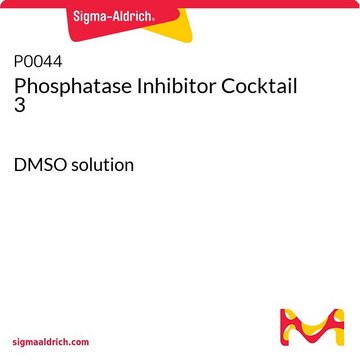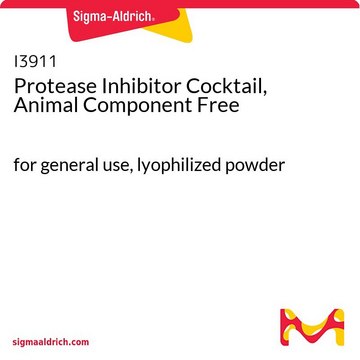535140
Protease Inhibitor Cocktail III
Animal-Free, liquid, for the inhibition of aspartic, cysteine, serine proteases and aminopeptidases
Synonim(y):
Inhibitor proteazy nieszkodliwy dla zwierząt
About This Item
Polecane produkty
Nazwa produktu
Protease Inhibitor Cocktail Set III, Animal-Free, Protease Inhibitor Cocktail Set III, Animal-Free, is a cocktail of six protease inhibitors with broad specificity for the inhibition of aspartic, cysteine & serine proteases & aminopeptidases.
Formularz
liquid
producent / nazwa handlowa
Calbiochem®
warunki przechowywania
OK to freeze
avoid repeated freeze/thaw cycles
rozpuszczalność
water: soluble
Warunki transportu
wet ice
temp. przechowywania
−20°C
Opis ogólny
Działania biochem./fizjol.
Aspartic, cysteine, and serine proteases as well as aminopeptidases
Ostrzeżenie
Postać fizyczna
Rekonstytucja
Informacje prawne
Hasło ostrzegawcze
Warning
Zwroty wskazujące rodzaj zagrożenia
Zwroty wskazujące środki ostrożności
Klasyfikacja zagrożeń
Eye Irrit. 2 - Skin Irrit. 2
Kod klasy składowania
10 - Combustible liquids
Klasa zagrożenia wodnego (WGK)
WGK 2
Temperatura zapłonu (°F)
188.6 °F
Temperatura zapłonu (°C)
87 °C
Certyfikaty analizy (CoA)
Poszukaj Certyfikaty analizy (CoA), wpisując numer partii/serii produktów. Numery serii i partii można znaleźć na etykiecie produktu po słowach „seria” lub „partia”.
Masz już ten produkt?
Dokumenty związane z niedawno zakupionymi produktami zostały zamieszczone w Bibliotece dokumentów.
Klienci oglądali również te produkty
Nasz zespół naukowców ma doświadczenie we wszystkich obszarach badań, w tym w naukach przyrodniczych, materiałoznawstwie, syntezie chemicznej, chromatografii, analityce i wielu innych dziedzinach.
Skontaktuj się z zespołem ds. pomocy technicznej
















